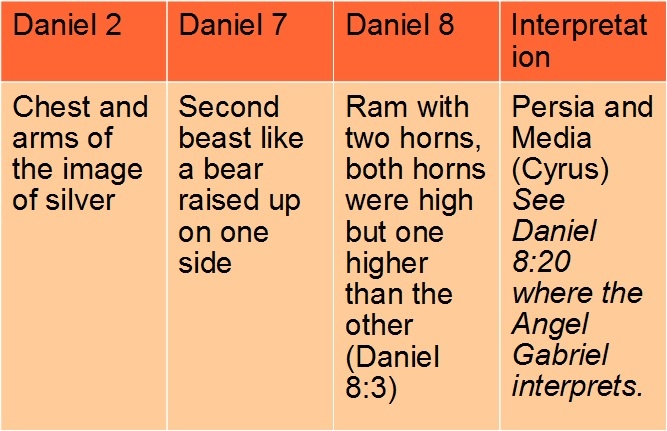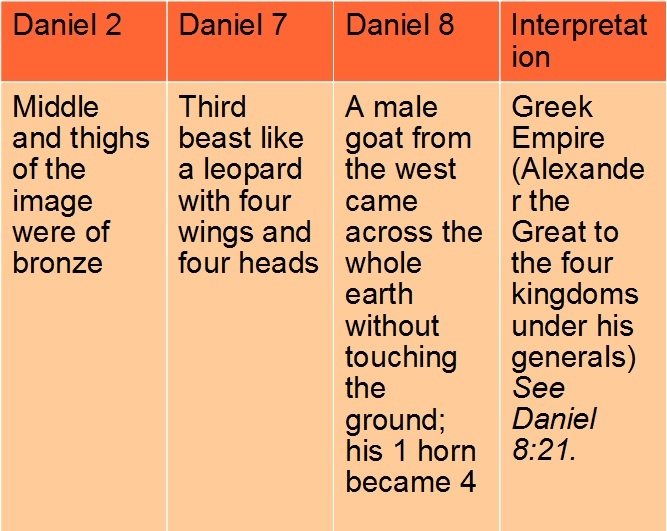I offer this article as a starting point for understanding Daniel 8 and 9. These chapters are apocalyptic visions and need to be interpreted as such. When I say that we could add these things to our table I am referencing the table available in the previous article on Daniel.
Daniel 8
The vision of Daniel 8 was given to Daniel ”in the third year of the reign of King Belshazzar,” (Daniel 8:1) and thus this vision was given to Daniel after that found in Daniel 7 (”in the first year of Belshazzar king of Babylon”). However, the focus of this vision is on an earlier time than the focus of Daniel 7. That is, the little horn of Daniel 8 describes a ruler who lived before the Roman Empire while the little horn of Daniel 7 describes our present.
We could add the following to our table:


Thus the context of the little horn described in Daniel 8 is near the end of the Greek Empire and before the Roman Empire. Remember that the context of ”another horn, a little one” that plucked up three of the first horns by the roots was under the heading of the Roman Empire.
Maybe a chart comparing the little horns would be helpful.

The little horn of Daniel 8 is no doubt identified in history as Antiochus IV Epiphanes. He profaned the temple in Jerusalem by introducing a holy object from Zeus worship thought to be a meteorite and sacrificing an unclean pig to it. This is therefore called the abomination of desolation. Antiochus IV Epiphanes also killed many Jews on the Sabbath and did other things to prohibit the lawful worship of our God. The little horn of Daniel 7 likewise changed the law and killed the saints and set himself up as an antichrist.
The answer to the question ”How long?” is another symbolic number. 1,150 days is more than three years but less than three and a half years. You will remember that the little horn of Daniel 7 by contrast was for three and a half periods of time.
My purpose in comparing and contrasting these little horns is so that you can see that Antiochus IV Epiphanes is not the same as but is a type of the final little horn. Indeed, the abomination of desolation in Daniel 8 should make you think of the abomination of desolation that took place in AD 70 as prophesied by Jesus. Thus both Antiochus IV Epiphanes and the final little horn do something similar.
Daniel 9
Daniel 9 is a vision given to Daniel ”in the first year of Darius the son of Ahasuerus, by descent a Mede, who was made king over the realm of the Chaldeans” (Daniel 9:1). The year would therefore be 539 B.C. Here Daniel is meditating on the significance of Jeremiah’s prophecy that the exile would last 70 years (cf. Jeremiah 25:11-12 and 29:10). Seventy is a symbolic number in that it is seven times ten – it is ten week years or a full number of Sabbath years. However, the death of King Belshazzar did not lead to the immediate restoration of Israel from exile. Re-reading Jeremiah and the prophets Daniel would have seen that the restoration only takes place after repentance and confession of sin and turning to God wholeheartedly. Thus Daniel offers up in this chapter a model prayer of confession. The angel Gabriel responded to the model prayer given by this model Israelite with an interpretation of Jeremiah’s words that raise more questions than answers in the minds of many. It is a fitting answer for apocalyptic literature. Gabriel says there are seventy weeks, thus Gabriel only counts every seventh year adding up to seventy sevens of years (i.e. 490 years). You may recall from Leviticus 25 that after a period of 49 years there was to be a fiftieth year called Jubilee. 490 is 49 tens and thus it is a full number of Jubilee periods and would be followed by the Jubilee of Jubilees.
The first Jubilee period (7 weeks is 49 years) was how long it would take for the restoration of the temple. Then there would be 62 more week years where Israel would repeat their history of failing to keep the law. 62+7=69. The seventieth week year is when things change.
The seventieth week year has two halves – each consisting of 3.5 ”days.” The abomination of desolation in AD 70 took place in the middle of that final week-year. There is a period of 3.5 from the death of Jesus to the destruction of Jerusalem in AD 70. And there is a period of 3.5 from the destruction of Jersualem in AD 70 to the return of Jesus Christ. This is the timing of the final little horn we met in Daniel 7. We know this because the text tells us that ”He shall make a strong covenant with many for one week, and for half of the week he shall put an end to sacrifice and offering” (Daniel 9:27). Sacrifice and offering came to an end when the second temple period came to an end – that is, when the second temple was destroyed in AD 70. thus AD 70 is in the middle of the seventieth week.
My sermon on Daniel 9 shows that there are three pairs (total of six) of objectives for the seventieth week. After those six objectives are completed then there would be Sabbath rest. This follows the pattern of creation.
Thus when Jesus comes again He will usher in the Jubilee of Jubilees.
Remember the significance of 3.5 is that it is not 3+1. Add to this the thought that 3.5+3.5=7 and the plus one day is the day of the Lord (the eighth day of creation). My larger point being that these numbers are symbolic, as we should expect considering the conventions of apocalyptic literature and the symbolic nature of many numbers from Genesis to Revelation.
Recent Comments